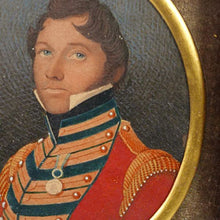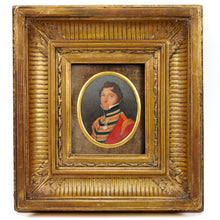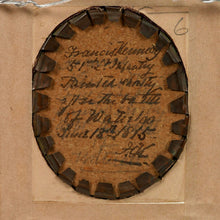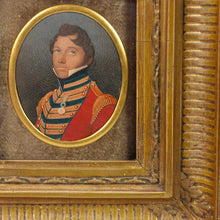Peninsula and Waterloo - Portrait Miniature an Officer of the 51st Foot, 1815
Adding product to your cart
Overall: 20cm (8in) x 18cm (7.1in)
Watercolour on ivory. Quarter length portrait of Lieutenant Francis Kennedy, 51st Foot. Contained in period frame, applied verso with period manuscript label inscribed ‘Francis Kennedy / 51st Lt. Infantry / Painted shortly / after the battle / of Waterloo / June 18th 1815 / JCK’. This item is being sold under Ivory Submission reference: VBNTTPLD.
Captain Francis Kennedy (1794-1857) was commissioned Ensign into the 51st Foot (2nd Yorkshire West Riding) Light Infantry in April 1809. The 51st Regiment of Foot had just been awarded the additional title of Light Infantry for its distinguished service in the retreat to Corunna under the late Lt-Gen. Sir John Moore, who had previously served in the 51st. The following summer (1809) Kennedy went with the 1st Battalion on the ill-fated Walcheren Expedition. The 1/51st was decimated by the effects of the malarial swamps of Walcheren, losing 560 men of all ranks after landing there on 29 July 1809. It is probable that Kennedy like many other survivors suffered from malarial fevers for years afterwards.
Read more
Kennedy became Lieutenant in February 1811 and in April of that year joined Wellington’s Peninsula Army. The 1/51st was under the command of Lieutenant-Colonel John Mainwaring, and the battalion formed part of the new 7th Division under Major General William Houston, in which it was brigaded with a ‘motley band’ of the 85th (Bucks Volunteers) Light Infantry, Chasseurs Britanniques and eight companies of Brunswick Oels Jaegers, making it on paper at least, one of the new light infantry brigades. On 1 May 1811 Kennedy was present at the battle of Fuentes d’Onor, where to Wellington’s displeasure Colonel Mainwaring panicked and ordered the burning of a colour to prevent it falling into enemy’s hands. In June Kennedy went with the battalion to the Guadiana valley to assist in the siege of Badajoz. Here Mainwaring was wounded in the trenches and 99 officers and men of 1/51st forming the 'forlorn hope’ perished in successive failed assaults on a breach in the San Cristobal bastion.
Kennedy was subsequently present at the battles of Salamanca (1812), Burgos (1812), Vittoria (1813), Pyrenees, and Orthez (1814). Following the first abdication of Napoleon in April 1814 and exile to Elba, Kennedy embarked with 1/51st Foot at Bordeaux for Plymouth aboard Zealous on 17 June 1814. He was stationed with the battalion at Portsmouth when Napoleon escaped from Elba and returned to France in early 1815. Accordingly Kennedy sailed from that port to join Wellington’s army in Belgium on 23 March. The 51st disembarked at Ostend, some 539-strong. At Waterloo, the 51st formed part of Colonel Mitchell’s brigade and occupied a portion of the narrow road leading to the junction of the Hougoumont avenue with the Nivelles road. During heavy fighting, the French cavalry repeatedly tried to penetrate the allied infantry squares. On being repulsed, a body of cuirassiers was intercepted in its retreat by British light dragoons and induced to surrender; but taking advantage of the weakness of their escort, they suddenly broke away and galloped down the Nivelles road hoping to reach the French lines. As they passed the high bank on the right of the road, a detachment of the 51st stationed in support opened fire killing 80 cuirassiers and 12 of their horses. The remainder, about 60, were taken prisoner or dispersed.
Francis Kennedy later became a Captain and Adjutant of the Royal North Lincoln Militia when commanded by the Earl of Portmore. In 1848 he received the Military General Service medal with six clasps. He died on 4 May 1857 and is buried at the Eastgate Cemetery, Lincoln.








